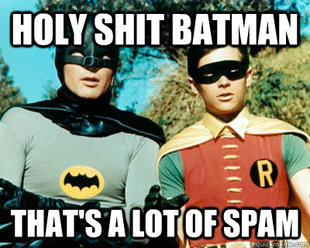
We’ve all had the same experience.
We see a great YouTube link on our social channels, we click and are quickly met with a pesky advertisement that won’t vanish until 30 seconds or more...
Or to use a music example, you follow a promising artist on Twitter, only to receive various spammy autoresponders in your inbox begging for a listen or download of their latest track.
In the marketing world, these messages that you can’t escape are called interruption marketing. This includes pop-up ads that make you want to break your computer, radio and TV commercials, or unsolicited emails that somehow escape your spam folder. In other words, they are everything you hate about the internet.
The wonderful opposite to these messages is referred to as “permission marketing”.
The term was created by marketer, Scott Godin, who gives all the deets on that term here.
Permission marketing is the term used for advertising messages that the consumer has given permission to receive. Sounds nice, right? This includes a newsletter with an opt-in feature, or a blog where users have the option of going to read the posts as they please. By definition, since users choose to follow a brand's social media in order to receive messaging, social media posts are also a form of permission marketing.
Permission marketing should be your go-to avenue for marketing music! Here are some sure-fire tactics to make sure your brand stands out from the crowd. Let’s do this.
1. Even Out Your Social Media & the 70-20-10 Rule
While fans may have “opted in” to your social media by following you or your brand, make sure they are getting a well-rounded point of view of your branding.
No fan wants constant tweets, posts and photos saying: listen to this music, buy my music, stream this music -- instead, they want a well-rounded view of who your brand is. Should you share music? Absolutely! However, make sure you have a mix of personal posts and non-music related branding, as well as content that gives a fan humanzing glimpses of day-to-day experiences. Don’t just spam work. It’s about personality, people.
One common rule given in the music (and advertising) industry is the 70-20-10 rule.
Your posts should be:
- 70% building your brand (a.k.a. personality)
- 20% networking and sharing posts
- and only 10% promoting your work.
Yup! That’s it. 10%. This should give you a well-balanced amount of posts that ensures your fans still feel as if they are the ones who gave the “option” and “permission” to receive content from you.

So, for instance, if you’re posting 10 times on Facebook:
-
Seven of those posts should be “brand building”.
These are things that showcase who your brand is. But keep in mind that these seven posts should showcase who you are in a way that’s not too promotional. So maybe it’s a photo of you or your artist in the studio, or a video of a musician thanking fans for attending last night’s show. This can also be tour photos, or candid artist shots. Anything is fine as long as it ties back to your brand!
And yes, these seven posts can also include showcasing music, but try and put a story behind it, and keep it sparse and most importantly, free! For instance, “Here's a cover of one of my favorite childhood tracks last night and figured I would showcase it, let me know what you think!”
Or... “Here’s some live footage of last nights show for those who didn’t make it!"
These aren’t too in-your-face and still show your music, brand, and personality.
-
Two of those posts should be networking and sharing others work.
So maybe share a track that you like by a local artist, or maybe an article about the music industry or music tips (hey… maybe even this blog!).
-
One post a week should be promoting your work.
Here is where you should get promotional! Pitch that iTunes link, or that merch page -- try and make those sales! Still write a personal message thanking your readers or give some sort of additional flare to the message though.
2. Get Rid of Those Auto-Responders
Let’s just knock this one out off the bat. If a fan is following you on social media, they want to interact (listen to music for example) -- that’s a given. Therefore, let them find it organically or through links in your bio rather than spamming their inbox with auto-responder messages. This applies to automatic concert announcements too (Bandsintown, etc.).
This is a very impersonal way to share music, especially if it comes off as robotic and is obviously a canned statement. Give fans the options to consume music as they wish!
Instead, when someone follows you, send them a direct tweet saying: “Hey [Name], appreciate the follow! How did you find me? BTW I see we’re both vegan, so high five.”
Relate and be personable!
3. If you are Pitching a Song, Pitch it — Don't Spam It

Let’s say you have a new release and you want it to be picked up by a few websites and blogs.
While it’s certainly common to send out a newsletter to fans and media that have subscribed to your newsletter, what’s not okay is adding unsolicited email addresses to that blast and sending it out. You know what this feels like, right?
This unsolicited email will likely go into their spam folder, and if reported as spam enough, it can actually shut down your email account. The major issue here is that it’s not only spam but it’s also a very impersonal way to communicate with potential fans and media outlets.
If you have a new release or piece of work to send to media, instead of sending the same eblast to 1,500 people, write out a formal press release or a quick blog pitch. Make it personable to writers and tell them how you love their work, discuss specific articles and prove to them why your work would be great for their publication. This should also not be in a newsletter format, ie. MailChimp, or Mad Mimi. Instead it should simply be a personal email.
4. Understand Newsletter vs. Blog Pitch
A newsletter, should be for fans (and sometimes media) who have opted in. Newsletters are usually sent 1-2 times a month and are general information regarding your brand-- news, tour updates, links to sales info, whatever it is that you do.
A blog pitch, on the other hand, is an email that’s sent only to media when you have a new piece of material to send for consideration. Just as you would give fans the option to opt-in or opt-out, media should certainly be the same way.
Again, fans should always be able to choose whether or not to receive messaging from you! Never send something out just to send it! It’s a HUGE way to turn off fans, and media, who are most certainly your life blood.
So there you have it! Those are a few quick ways to make sure that you are coming off as the personable and friendly music industry professional that you are -- rather than a spastic promotional robot who just doesn’t know how to quit. Following these rules will give your online media a personable and authentic boost.


